“No sales, no company.”
That aphorism, from billionaire entrepreneur Mark Cuban, highlights how vital marketing is to a company’s success.
And if you’re tasked with managing your company’s marketing efforts, that makes you indispensable — as long as you get results.
This guide will help you do just that as we cover everything you need to excel at marketing management and prove how indispensable you truly are.
- Overview of Marketing Management
- Anatomy of a Successful Marketing Management Team
- 6 Skills Required of Effective Marketing Managers
- How to Develop Your Marketing Strategy
- How to Develop Your Marketing Plan
- How to Allocate Your Marketing Budget
- How to Measure & Track Marketing Performance
Let’s start at the top.
Overview of Marketing Management
Marketing management is the process of planning, overseeing, and directing brand awareness and growth activities for a company.
That’s an intentionally vague definition because a lot of activities fall under the Marketing Management umbrella regardless of your company’s size and maturity.
Most Marketing Managers are tasked with the following responsibilities:
- Develop your marketing strategy
- Develop your multi-channel marketing plan
- Execute your planned marketing campaigns
- Measure campaign results
- Optimise campaign performance
If you’re a solo entrepreneur or work for a small company, you may handle everything above by yourself.
If you work for a larger company, you may manage (or be part of) a marketing team that works together to achieve your company’s business goals.
Let’s start with the composition of a successful marketing team.
Anatomy of a Successful Marketing Team
Successful marketing teams come in all shapes and sizes. What matters most is that the team’s structure is designed with their business objectives and workflow in mind.
However, there are a few best practices to consider if you’re building your marketing team from scratch. At a high level, there are seven different tiers with a variety of specific positions within each:
- Decision-makers: Top-level roles with sign-off power.
- Strategists: Big-picture thinkers who create key strategies for decision-maker approval.
- Managers: Responsible for the day-to-day operations and performance of business units.
- Campaigners: Oversee the execution and performance of individual campaigns.
- Specialists: Technical experts with a narrow focus, such as design or copywriting.
- Analysts: Data linguists who track performance and find new opportunities.
- The super-subs: Freelancers and contractors who cover the gaps of your in-house team.
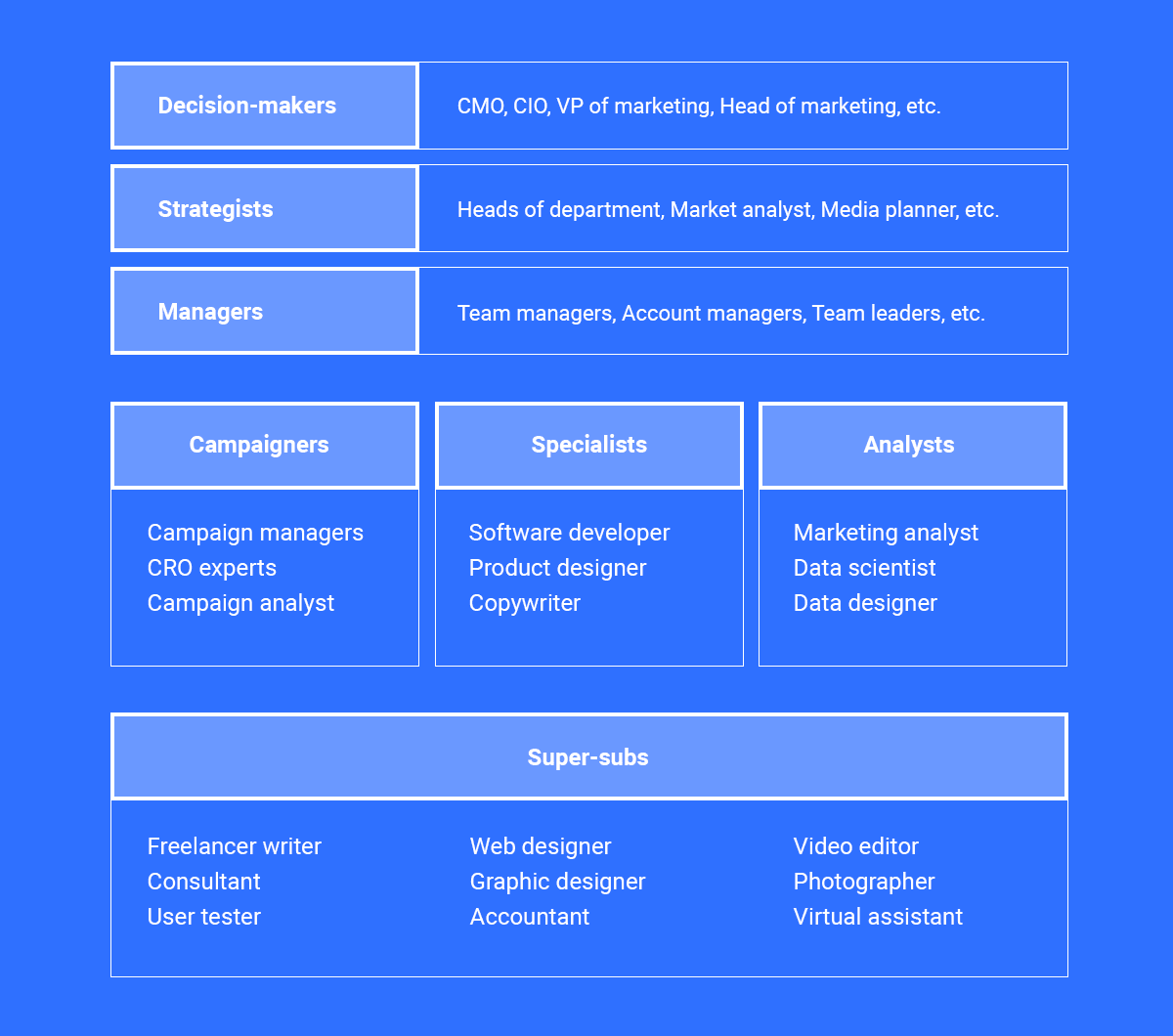
Marketing Management requires overseeing all of these tiers, which doesn’t necessarily mean having managerial authority over every tier. Many Marketing Managers sit in the managers tier, and they probably aren’t bossing CFOs around.
Instead, they’re communicating up and down the hierarchy of tiers, which requires cross-functional expertise.
Plus, these six skills.
6 Skills Required for Effective Marketing Management
Marketing Management’s wide range of responsibilities requires an equally wide range of skills and competencies:
- Leadership
- Creativity
- Adaptability
- Technical competency
- Performance analysis
- Communication
Let’s explore each.
1. Leadership
Management of all types — not just marketing — requires strong leadership skills:
- Strategic thinking
- Organisation
- Goal setting
- Personnel management
- Team building and motivation
- Guidance and mentoring
- Delegation
You need the ability to understand both C-Level strategy and campaign-level tactics, often switching between the two at a moment’s notice, while managing a multi-faceted team responsible for executing multi-channel campaigns in a complex and competitive business landscape.
Leadership skills aren’t optional.
2. Creativity
Marketing requires creativity and out-of-the-box thinking. Your marketing leadership role doesn’t make you responsible for coming up with every creative idea (unless you’re the only marketing resource your company has), but having some creativity helps.
3. Agility
Today’s business environment is more dynamic and fast-paced than ever. That’s especially true for marketers, who are tasked with capturing their audience’s attention via countless crowded channels — and new channels seem to pop up every week.
To cut through the noise and rise above the chaos, marketing teams are turning to agile marketing, a work management methodology that emphasises visibility, collaboration, adaptability, and continuous improvement.
Agile Marketing replaces the traditional months-long planning process (think Gantt charts) with a series of 1-3 week Sprints — short periods of highly-focused, results-driven work that gives teams the ability to reprioritise regularly.
Unsurprisingly, Agile Marketing requires agile marketers.
What are the benefits of switching to Agile?
CMG Partners surveyed CMOs, senior marketing executives, and Agile experts from over 40 companies, and 87% reported that Agile made their teams more productive.
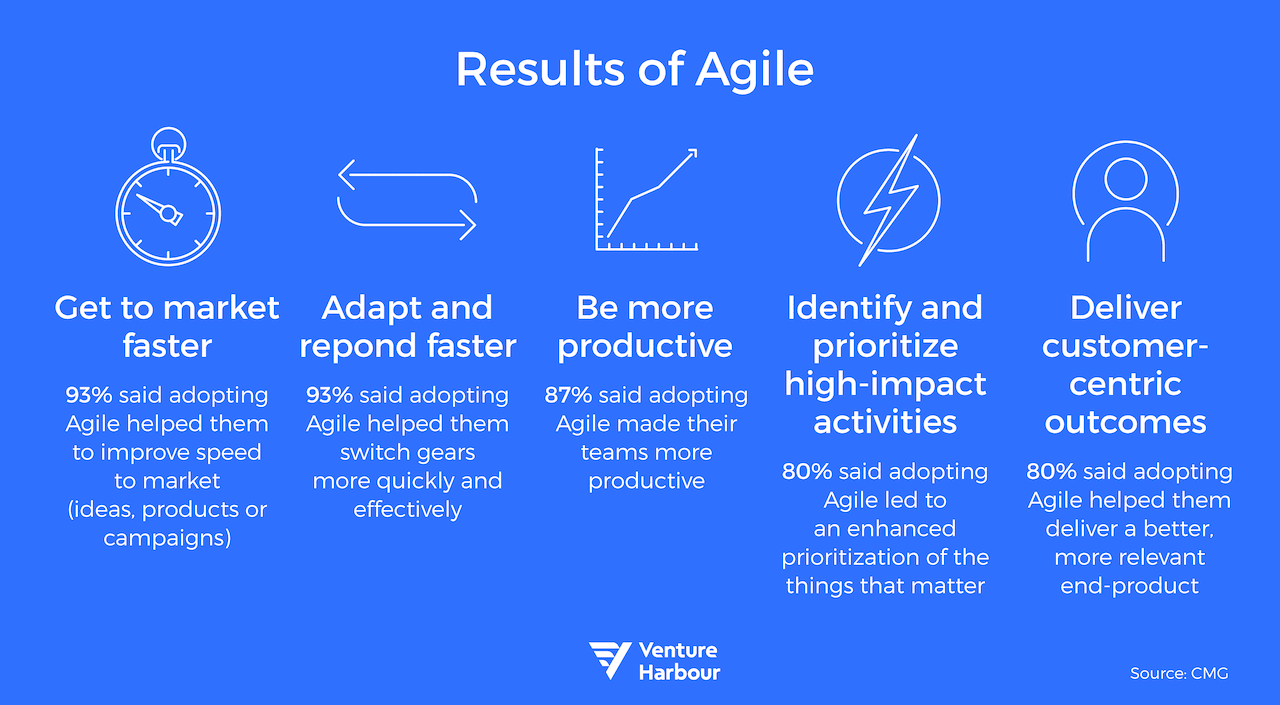
4. Technical competency
Managers don’t need to have technical proficiency in every marketing task (unless you’re handling everything yourself), but there are a few technical skills you should have:
- SEO, SEM, UX, and responsive design
- Understanding of the specific channels your business uses, such as Facebook or PPC
- Email marketing, sequences, copywriting, and segmentation
- Fluency with your business’s marketing management tools
Marketing strategies and campaigns vary greatly from industry to industry, and even between companies within a single industry, so the specific tools you’ll need vary as well.
Most companies prioritise email marketing because it has one of the highest ROIs of any marketing channel (3800%). If your company focuses on email marketing, there are a few email marketing tools you may need to use.
Beyond email marketing, you need proficiency with other tools to help streamline planning and reporting, lead generation, conversion optimisation, search marketing, and social media marketing. Like above, there are tons of different tools out there, but here’s a roundup of 30 free marketing tools.
5. Performance analysis
The best marketing teams continuously test new ideas and optimise winning ones to squeeze every ounce of benefit out of their highest-performing campaigns.
This cycle of execute, measure, prioritise, optimise integrates seamlessly with the Agile Marketing methodology. It also requires marketers to track, analyse, and prioritise all of their campaigns, which gets complicated in a hurry.
TrueNorth makes this process easy, giving you one less thing to worry about.
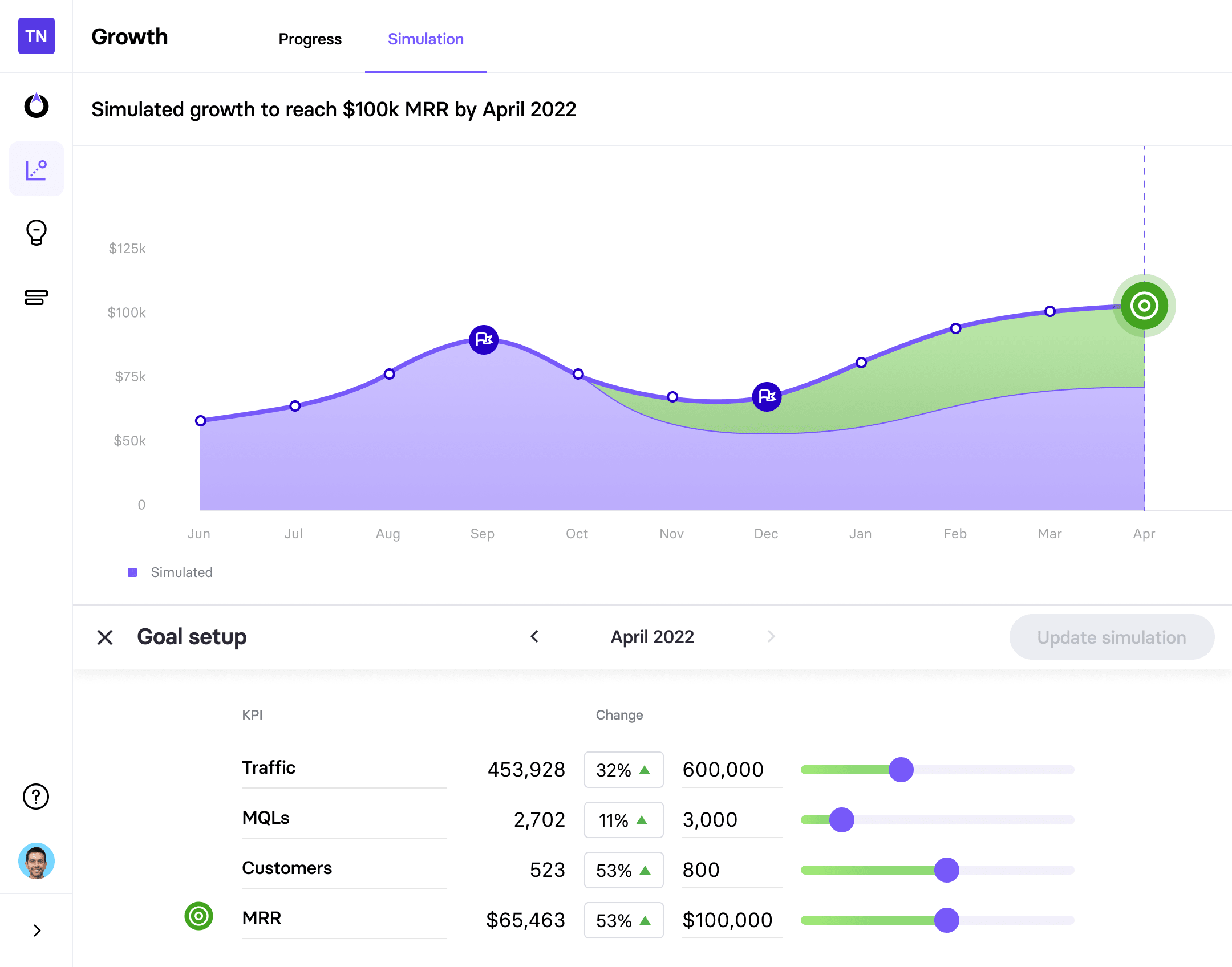
TrueNorth’s greatest benefit is its simple interface, which lets you simulate, plan, and track all of your company’s marketing activity in one place.
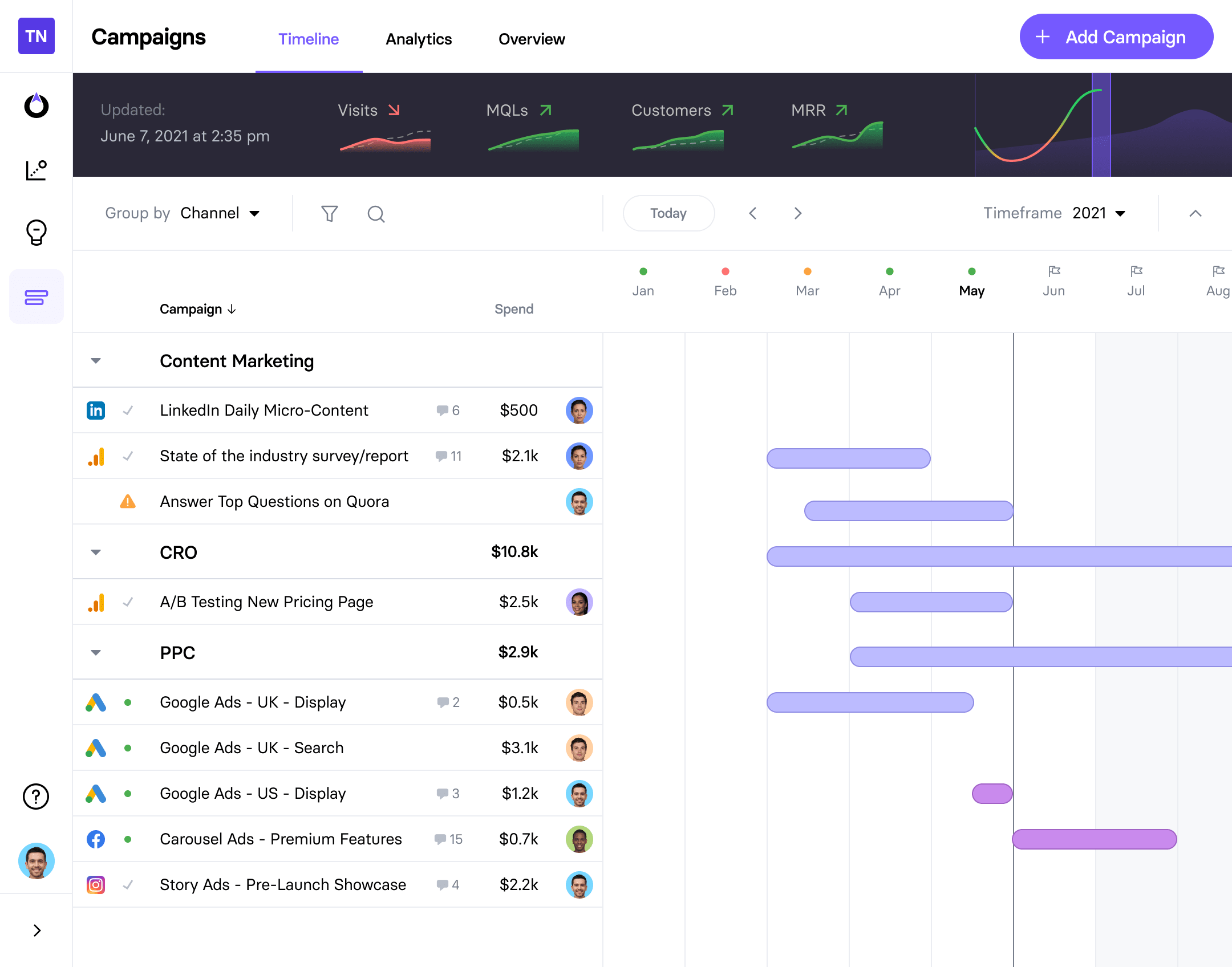
With TrueNorth, you can report your marketing team’s efforts with meaningful metrics that C-Level executives want to see. That means more credibility and higher marketing budgets.
6. Communication
Communication could have been lumped with leadership, as it’s a critical component of managing a high-performing team, so why is it called out separately?
Communication extends up the food chain too.
A core part of Marketing Management is communicating strategic direction, performance, and marketing ROI to C-Level executives.
What marketing needs to get better at is having it ingrained that it’s about profitable growth…not growth ‘at any cost.’
You absolutely must be able to tie your team’s marketing efforts to identified business objectives and communicate that value in clear terms.
This is where tools like TrueNorth shine.
How to Develop Your Marketing Strategy
Your marketing plan guides your team’s actions, and your marketing strategy guides your marketing plan.
That begs the obvious question: What is a marketing strategy?
A marketing strategy is not a list of the various campaigns you want to test. That’s your marketing plan (more on this a section below).
A marketing strategy is one level up and provides big picture direction. Typically, it includes the following four elements:
- Business objectives: What does success look like? More sales or revenue?
- True North success metrics: How do you measure that success? Incremental sales or revenue? Possibly incremental leads for businesses focused on growth marketing?
- Segmented target audience: Who is your target customer? Is there more than one?
- Channels to reach that audience: Where is your target customer?
The order of those four elements matters.
- Your objectives (what success looks like) drive your metrics (how you measure that success).
- Your audience (target customers) drives your channels (where those customers are).
Nothing in this strategy explains how you’ll market to your target audience or what you’ll say. That’s your marketing plan.
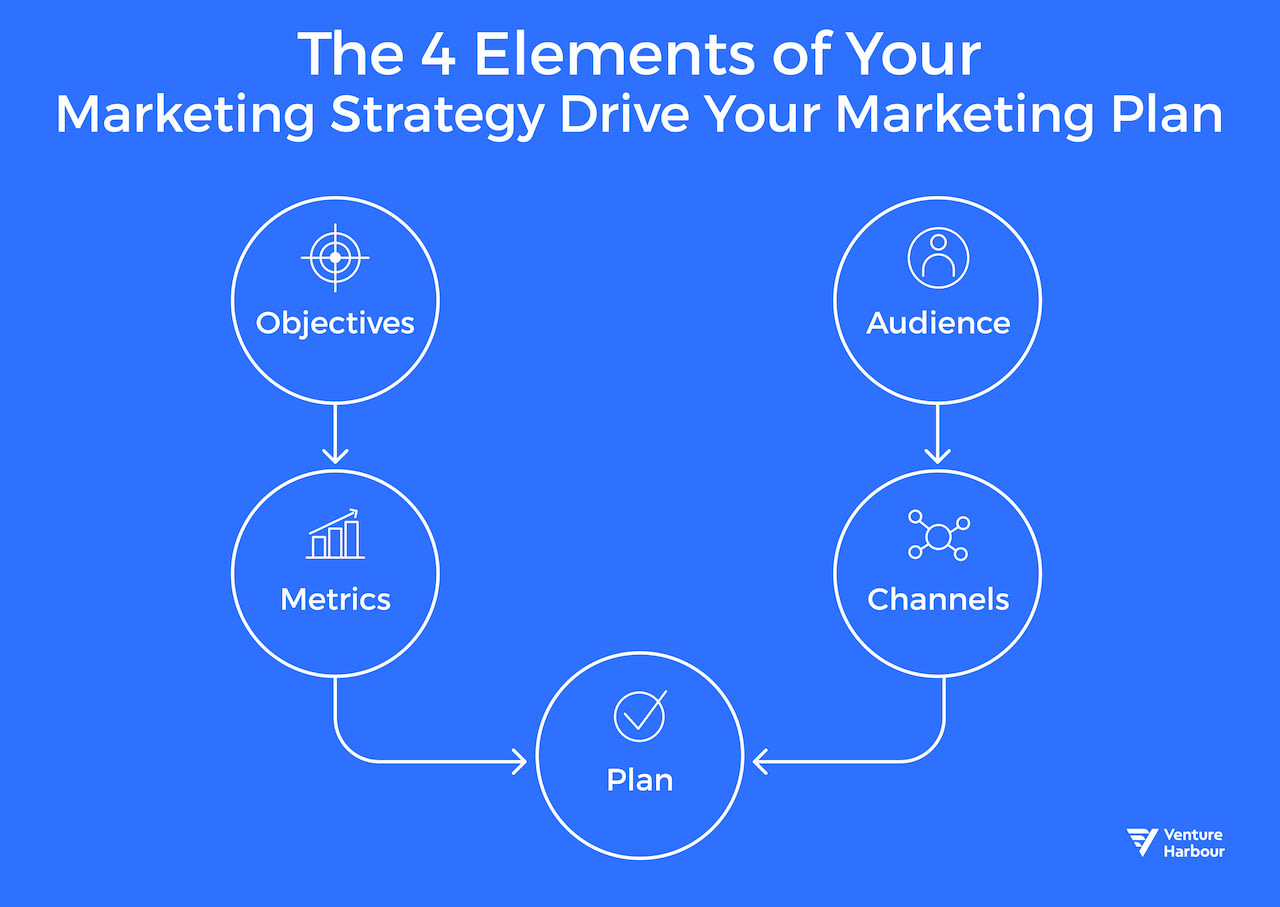
Identifying Your Target Market
Identifying your target audience begins with identifying your target market. While market and audience sound similar, there’s a distinction between the two:
- Target Market: The broad group of potential customers your brand and products appeal to.
- Target Audience: A subset of your broad target market to which you can market a particular product or idea.
If your company sells all-natural pet supplements, your target market is pet owners while your target audiences are dog owners, cat owners, and senior pet owners (among others).
Beginning with your target market gives you a big picture look at all of your potential customers, which has several significant advantages:
- Understand the size of your company’s potential customer pool
- Understand your competitors, position within the market, and market share
- Gives you a starting point when segmenting your target market into narrower target audiences
- Allows you to compare the potential of each target audience to maximise the likelihood of investing in high-ROI marketing campaigns
How do you identify your target market? It begins with two introspective questions:
- What is your brand?
- What are your products?
You can’t market a product and brand you don’t understand, so who are you and what are you selling?

Our guide to the Art & Science of Finding Your Target Audience dives deeper into identifying your target market and is worth a read.
Identifying & Segmenting Your Target Audience
Your target audience is a subset of your target market. It’s the people you’re trying to market a specific product/message to because they’re specifically interested in that product/message (even if they don’t know it yet), and you can have more than one target audience.
In most cases, further refining your target audience results in better conversion rates and campaign ROIs because you’re serving a more focused and personalised message that resonates more closely with your audience’s wants and needs.
Marketing segmentation is the process of refining your target market into narrower target audiences who share the same customer profile (or persona) and are likely to react favourably to your focused marketing campaign.
There are five ways to segment your target audience based on the various traits, behaviours, and characteristics your target customers have:
- Demographic: Quantifiable, population-level characteristics (age, sex, income)
- Geographic: Physical location (country, city, urban vs rural)
- Psychographic: Personality traits, likes, and dislikes (introvert vs extrovert, values, activities)
- Behavioural: Actions and interactions associated with your brand or other brands (impulsiveness, funnel status, brand loyalty)
- Contextual: Instantaneous situation that modifies the other four segments (recent major life event, happy vs sad, shopping at home vs work)
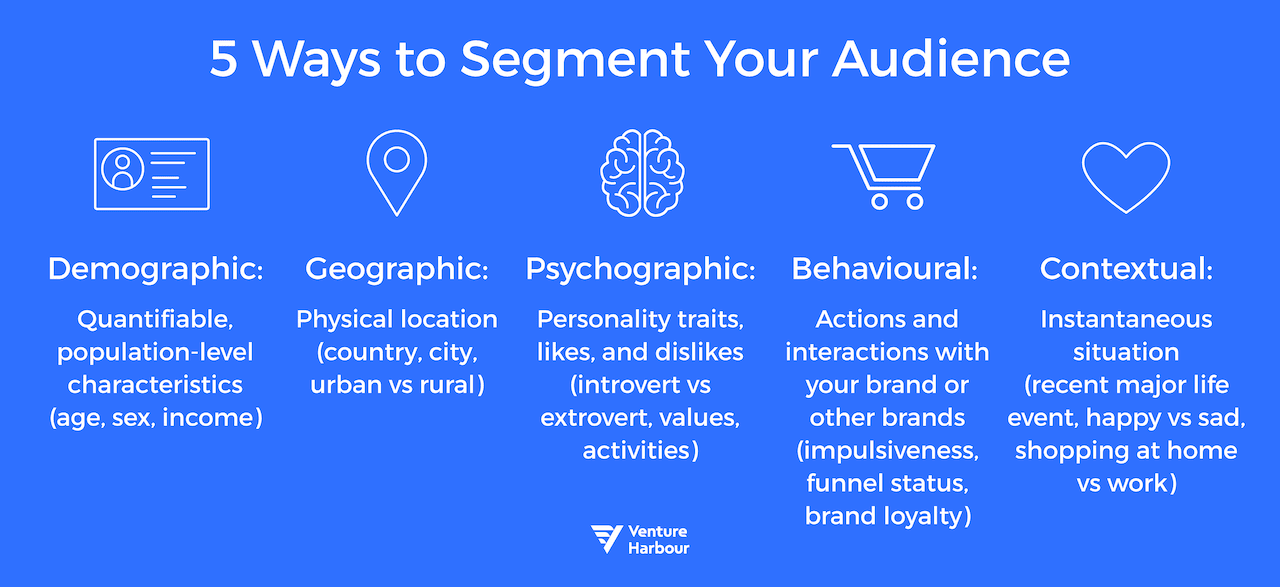
Consider a PPC search campaign for the brand mentioned above that sells all-natural pet supplements. We can segment our target market into narrower target audiences with increasing specificity:
- Very Broad: Animal lovers
- Still Broad: Animal owners
- Getting There: Dog owners
- Focused: Senior dog owners
- Hyper-Focused: Senior dog owners segmented by breed
In theory, we should see higher conversion rates as we move from Very Broad (animal lovers) to Hyper-Focused (senior dog owners segmented by breed).
Quick timeout: We’re still in the strategy phase and haven’t gotten to developing your marketing plan or budget (that’s the next section). Right now, you should be thinking about your broad target market and the various audiences you can segment them into. You shouldn’t be thinking at the campaign level just yet.
However, this is an excellent time to ask (and answer) an important question:
If hyper-focused segments generate better campaign-level returns, why doesn’t everyone get as hyper-focused as possible?
Cost.
As you continue to narrow your audience further and further, there are increased marketing costs:
- Creating separate email sequences or ad copy
- Creating separate landing pages
- Tracking each campaign’s performance
- Optimising each campaign
Somewhere between Very Broad and Hyper-Hyper-Focused exists a Goldilocks zone with the greatest marketing ROI — where your cumulative campaign returns are worth the increased cost and complexity.
Figuring out where this Goldilocks zone is requires a lot of organisation, testing, analysis, and performance measurement. This is where marketing management tools like TrueNorth becomes invaluable, letting you compare the performance of your many campaigns in a single, convenient dashboard.
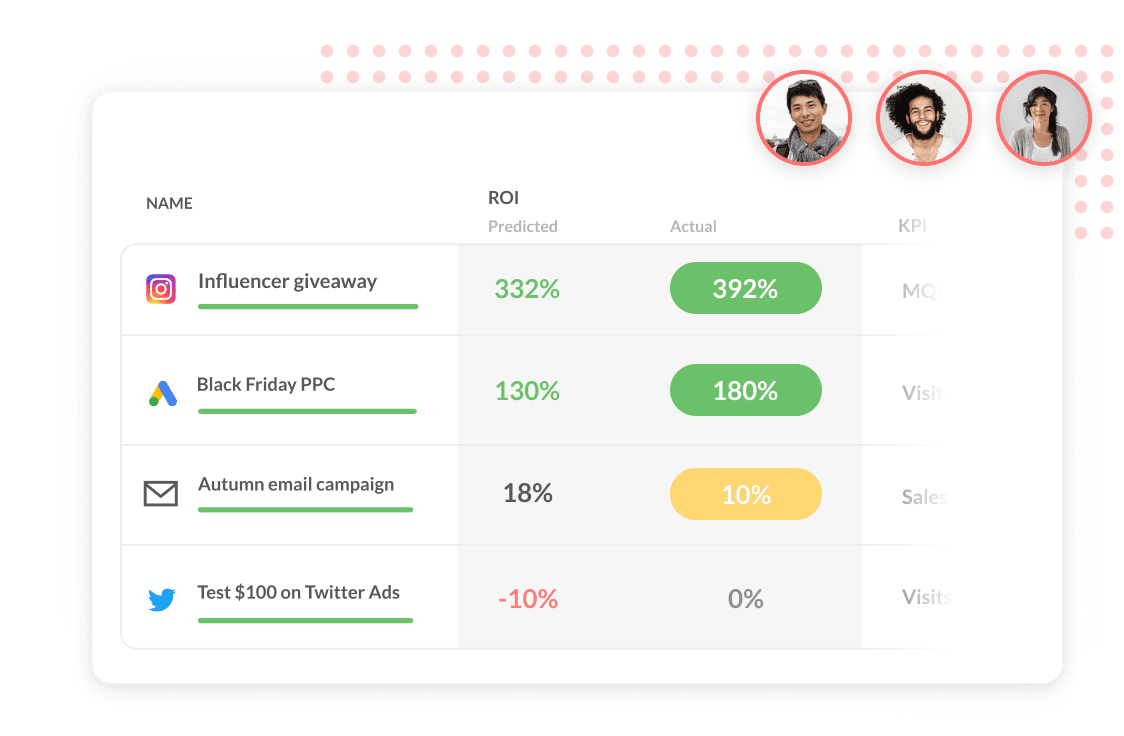
Identifying Your Core Channels
Your marketing channels are the media used to communicate with your target audience. Once you know your audience, you need to figure out where they are.
The channels you use are specific to your brand and industry, but here are some of the most common marketing channels:
- Social media
- PPC
- Content marketing
- Podcasts
- Traditional offline marketing (print ads, billboards, direct mailers)
Do you know which channels drive the highest marketing returns for your company? You may or may not depending on your company’s phase of marketing maturity.
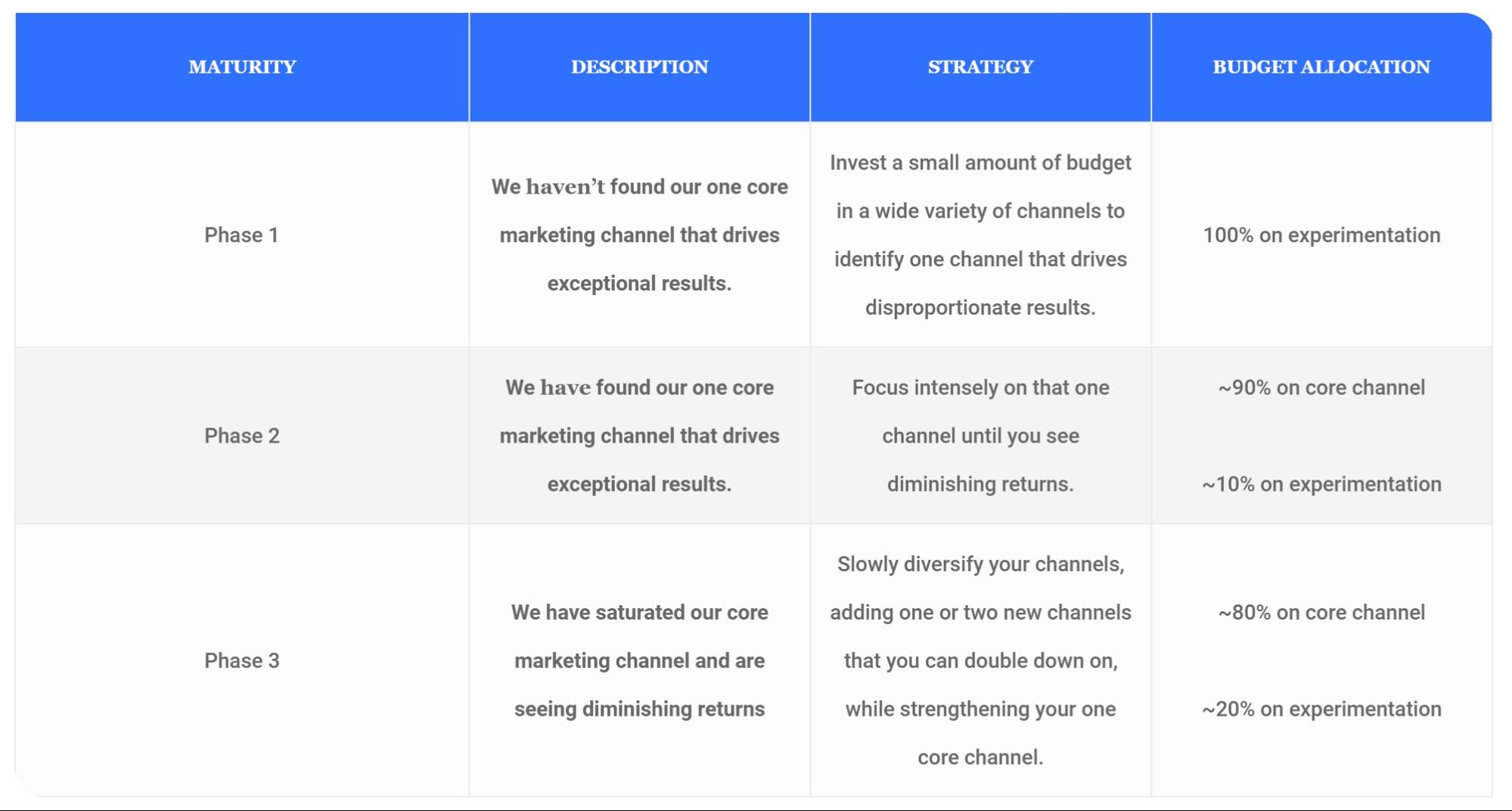
Continuous campaign performance tracking and optimisation are crucial to make sure you’re making the most of your marketing spend.
Our guide to the Ultimate Marketing Plan gives detailed, actionable steps for companies in all three phases.
How to Develop Your Marketing Plan
Your marketing plan is the set of specific tactics you’ll use to execute your marketing strategy. It should include the usual planning elements — SWOT analysis, tactics, and KPIs — but it should be flexible and able to adapt as we gain information on campaign performance.
It all comes back to agile.
The S.T.A.R marketing system is an alternative to the traditionally rigid marketing plan to allow for constant tuning. As the acronym implies, it has four parts:
- Strategy: Calibrate your marketing plan’s goal, audience, budget and channels
- Triage: Create and prioritise a list of campaign ideas and optimisations
- Action: Refine, approve, and launch agreed campaigns
- Report: Report back on campaigns that have ended
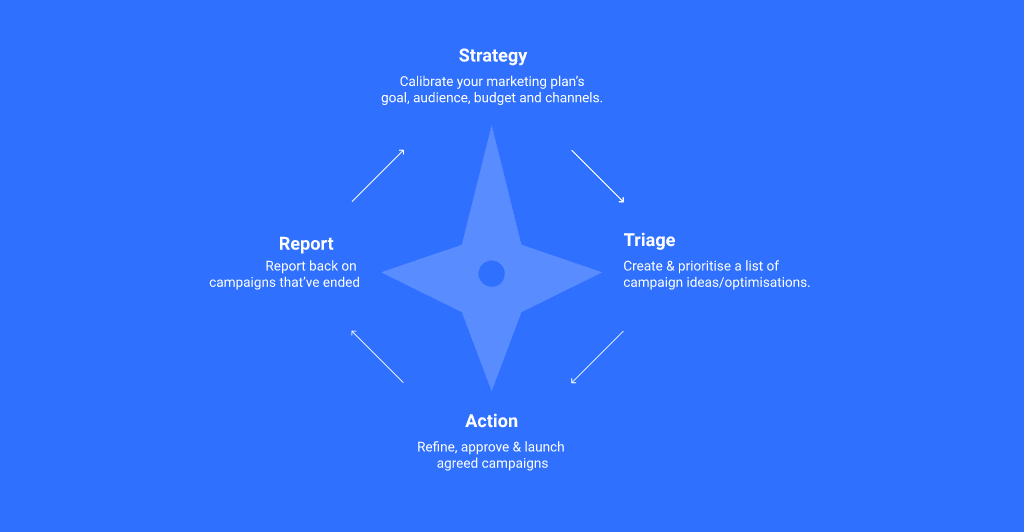
We’ve talked about your marketing strategy, and we’ll get to metrics in the next section, so let’s focus this section on Triage and Action.
Triage, in the marketing world, is the process of developing and prioritising a list of campaign ideas and optimisations. If you’re new to campaign brainstorming, start with ten ideas and use a prioritisation framework to compare and rank them.
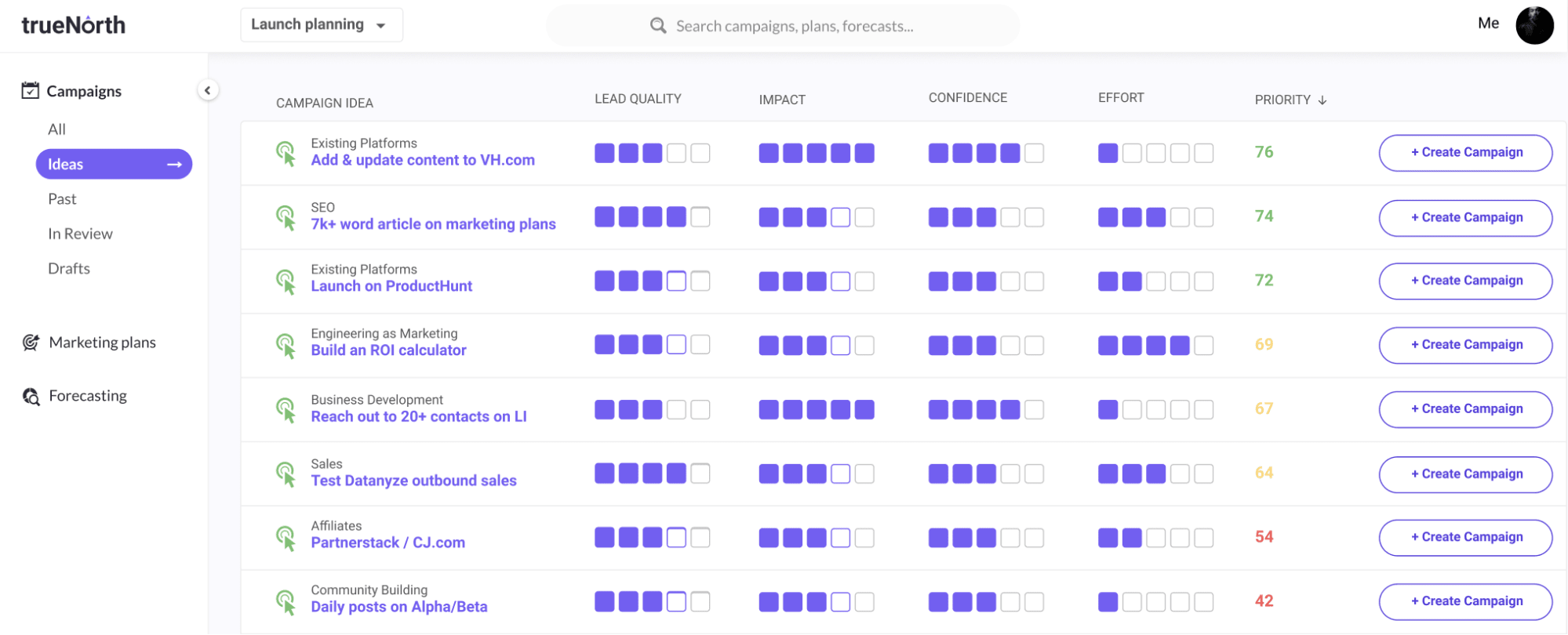
Action is the tactical work of refining, approving, and launching your prioritised campaigns. Each campaign should begin with a brief, which includes the following key elements:
- Campaign summary (name, channels, overview)
- Expected results (as a range, e.g. 50-75 leads)
- Expected budget
- Timeframe (start and end date)
- Prioritisation score
Campaign briefs are invaluable when communicating your vision to internal stakeholders and they help keep your campaign’s efforts focused.
How to Allocate Your Marketing Budget
Your marketing budget is the total money allocated to growth and promotion-related efforts over a defined period, such as one month, one quarter, or one year.
Your marketing budget is tied closely to your marketing plan, so now we have a “chicken or the egg” situation.
If your plan can inform your budget, and your budget can inform your plan, which comes first?
The answer depends on your specific company, their budgeting process, and the company’s attitudes and culture towards marketing. In general, there are two types of marketing budgets:
- Benchmark Budgets: Assign marketing spend based on a bottom-line number, like per cent of company revenue. They come before the marketing plan, and the allocated resources are used to figure out which marketing tactics to prioritise.
- Zero-Based Budgets: Assign marketing spend based on the estimated costs required to execute your marketing plan and achieve your business objectives. They come after the marketing plan, and the allocated resources are estimated based on the identified marketing tactics.
Zero-based budgets are significantly better because they’re goal-oriented. You know if you allocate $20,000 to marketing each month, you’ll hit your identified objectives.
That sounds great, but it requires two critical pieces of information:
1. Your company’s business objectives
2. The ROI of your marketing activities
Many companies don’t know either their business objectives or the ROI of their marketing activities (sometimes both) and simply allocate money to a poorly-defined row in their spreadsheet labelled “Marketing.”
If you’ve developed your marketing strategy, you already know your business objectives.
To understand your marketing ROI, you need to set up performance tracking.
How to Measuring & Track Marketing Performance
We’ve spent a lot of time talking about performance optimisation, but we haven’t talked about how you do that.
It all starts with marketing metrics, which are the statistics used to evaluate campaign performance. There are tons of different metrics to measure and track — we identified 51 critical marketing metrics — which we can categorise broadly into two major groups:
- Channel Metrics: The platforms or media you’re measuring
- Performance Metrics: The results or outcomes you’re achieving
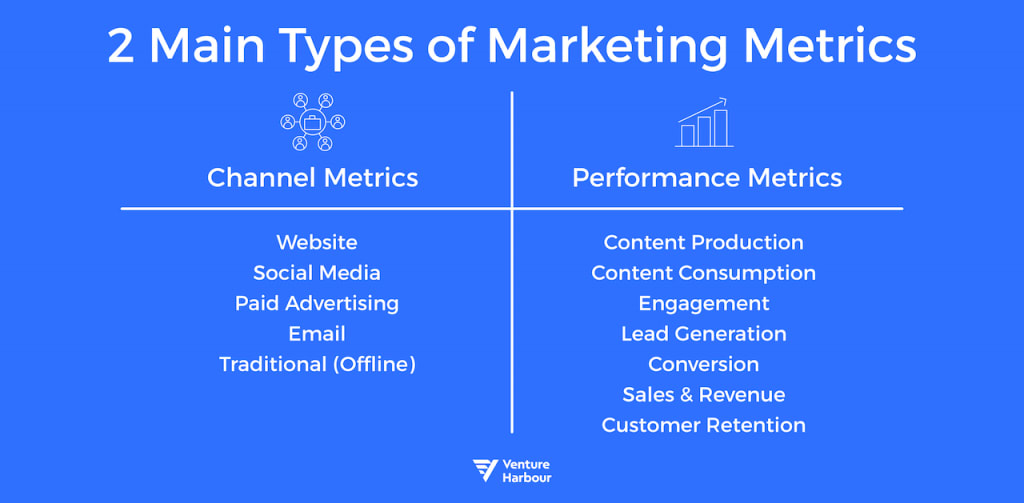
If there’s just one thing you remember from this section on marketing metrics, make sure it’s this:
Make sure you track campaign performance metrics that tie to your company’s identified business objectives and communicate campaign performance, value, and ROI to executive leadership.
Put another way, track the results of your marketing efforts using the metrics your company cares about.
- If your company cares about generating more revenue, measure and report the incremental revenue attributed to your campaign.
- If your company cares about lead generation, measure and report the number of marketing qualified leads (MQL) and sales qualified leads (SQL) your campaign generated.
- If your company cares about customer retention, measure and report the number of repeat customers your campaign drove.
That seems obvious, but too many marketers fail to connect campaign performance to business outcomes, instead reporting vanity metrics like social media impressions or email clicks or website visitors.
Yes, those metrics correlate with revenue, leads, and repeat customers, but how is your CFO supposed to reach when you tell them your email marketing campaign sent 50,000 emails and generated 5,000 clicks to your landing page?
What’s the value of those 5,000 clicks to the business?
You need to have a holistic understanding of each campaign by focusing on your funnel. If you’re trying to generate product sales with an email marketing campaign, you’ll need to measure the following raw count metrics:
- Sent emails
- Delivered emails
- Opened emails
- Email clickthroughs
- Product purchases
- Email unsubscribes
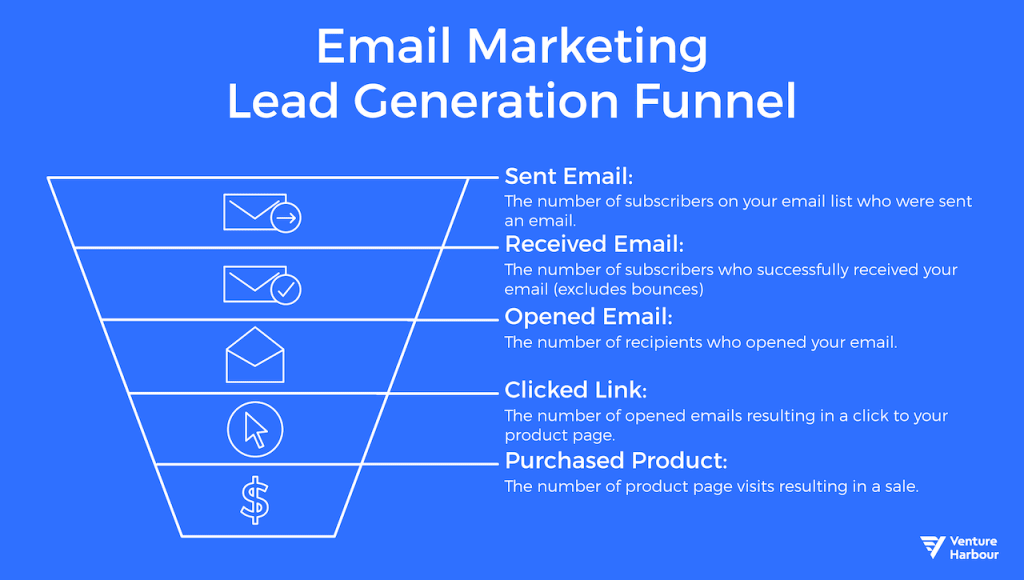
Those raw count metrics are vanity metrics (except for product purchases). You need to convert them to conversion rate metrics:
- Bounce rate: Number of sent emails which failed to deliver
- Open rate: Number of delivered emails which were opened
- Clickthrough rate (CTR): Number of delivered emails which resulted in a link click
- Click-to-open rate (CTOR): Number of opened emails which results in a link click
- Campaign conversion rate: Number of delivered emails which resulted in a sale
- Landing page conversion rate: Number of link clicks which resulted in a sale
- Unsubscribe rate: Number of delivered emails which resulted in an unsubscribe
We’re getting closer. These conversion rate metrics are great for comparing campaign performance to identify, prioritise, and optimise high-performing campaigns. Still, we can do better for our decision-making executives by factoring in campaign costs and revenues:
- Return on investment (ROI): Net revenue generated from campaign spend
- Customer acquisition cost (CAC): Cost to generate one new customer measured by (Campaign Spend) / (Number of New Customers)
- Customer lifetime value (CLTV): Amount of value the average customer generates for your business, generally reported as net revenue after expenses (not including marketing)
- CLTV-to-CAC ratio: Relationship between the campaign-driven value of one customer and the cost to acquire that customer (this absolutely must be positive)
These are the metrics your executives care about. If you’re trying to transition your company away from benchmark budgeting to zero-based budgeting, these metrics are how you do it.
Conclusion
Marketing Management is multi-faceted and complex, encompassing everything from C-Level strategy development to ground-level tactical execution. It requires you to be a skilled leader and communicator with both cross-functional familiarity and tactical, subject matter expertise.
Put bluntly, a lot is asked (and expected) of today’s marketing managers.
Marketers who balance the job’s many demands attribute their success to two factors:
- Well-developed processes and workflows
- Powerful marketing tools that seamlessly integrate with and streamline those workflows
Tools like TrueNorth, a marketing management system that helps marketing teams create adaptable plans, attribute value, and prioritise campaigns, are critical for marketers who want to rise above the chaos and become invaluable to their company’s success.
If you’re interested in joining our beta, you can join here. As a Venture Harbour reader, you’ll be jumped to the front of the beta queue.




